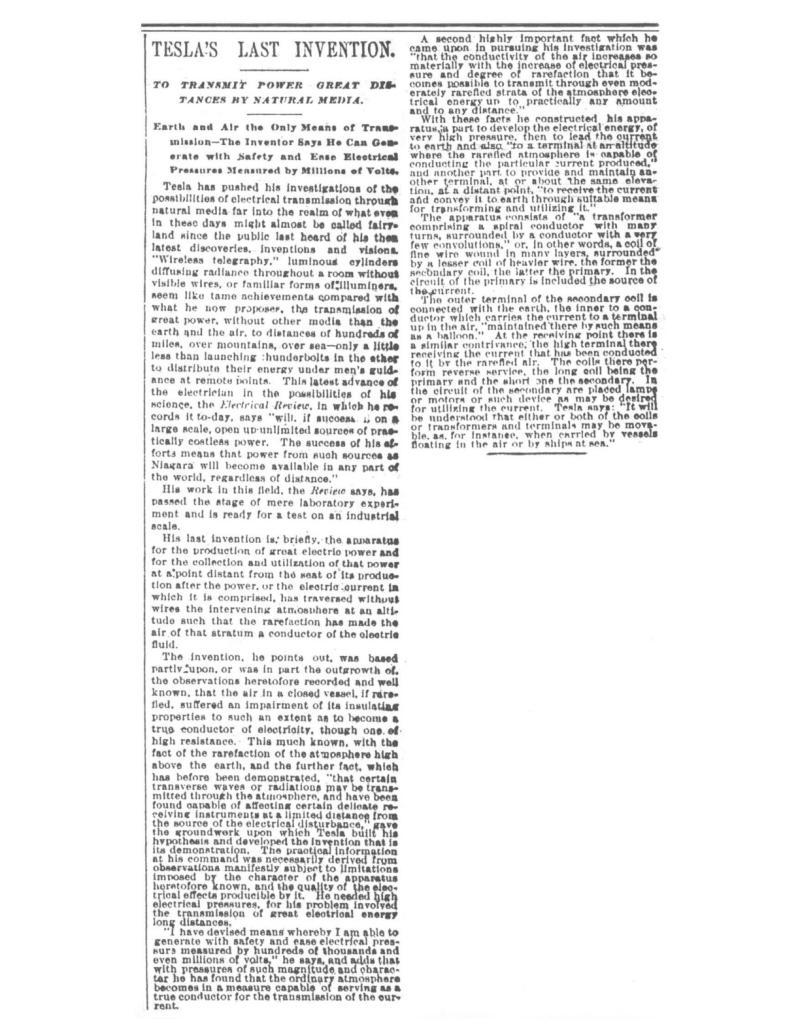
Nikola Tesla Articles
Tesla's Last Invention - To Transmit Power Great Distances by Natural Media
Earth and Air the Only Means of Transmission - The Inventor Says He Can Generate with Safety and Ease Electrical Pressures Measured by Millions of Volts.
Tesla has pushed his investigations of the possibilities of electrical transmission through natural media far into the realm of what even in these days might almost be called fairy land since the public last heard of his then latest discoveries. Inventions and visions "Wireless telegraphy." luminous cylinders diffusing radiance throughout a room without visible wires, or familiar forms of illuminers, seem like tame achievements compared with what he now proposer, the transmission of great power, without other media than the earth and the air, to distances of hundreds of miles, over mountains, over sea - only a little less than launching thunderbolts in the other to distribute their energy under men's guidance at remote points. This latest advance of the electrician in the possibilities of his science, the Electrical Review, in which he re cords it to-day, says "will. if success on large scale, open up unlimited sources of practically costless power. The success of his efforts means that power from such sources as Niagara will become available in any part of the world, regardless of distance."
His work in this field, the Review says, has passed the stage of mere laboratory experiment and is ready for a test on an industrial scale.
His last invention ism briefly, the apparatus for the production of great electric power and for the collection and utilization of that power at a point distant from the seat of its production after the power, or the electric current in which it is comprised, has traversed without wires the intervening atmosphere at an altitude such that the rarefaction has made the air of that stratum a conductor of the electric fluid.
The invention, he points out, was based partly upon, or was in part the outgrowth of. the observations heretofore recorded and well known, that the air in a closed vessel, if rarefied, suffered an impairment of its insulating properties to such an extent as to become a true conductor of electricity, though one of high resistance. This much known, with the fact of the rarefaction of the atmosphere high above the earth, and the further fact, which has before been demonstrated, "that certain transverse waves or radiations may be transmitted through the atmosphere, and have been found capable of affecting certain delicate receiving instruments at a limited distance from the source of the electrical disturbance, gave the groundwork upon which Tesla built his hypothesis and developed the invention that is its demonstration. The practical information at his command was necessarily derived from observations manifestly subject to limitations imposed by the character of the apparatus heretofore known, and the quality of the electrical effects producible by it. He needed high electrical pressures, for his problem involved the transmission of great electrical energy long distances.
"I have devised means whereby I am able to generate with safety and ease electrical pressure measured by hundreds of thousands and even millions of volts," he says, and adds that with pressures of such magnitude and character he has found that the ordinary atmosphere becomes in a measure capable of serving as a true conductor for the transmission of the our rent.
A second highly important fact which he came upon in pursuing his investigation was "that the conductivity of the air increases so materially with the increase of electrical pressure and degree of rarefaction that it becomes possible to transmit through even moderately rarefied strata of the atmosphere electrical energy up to practically any amount and to any distance."
With these facts he constructed his apparatus, a part to develop the electrical energy, of very high pressure, then to lead the current to earth and also "to a terminal at an altitude where the rarefied atmosphere is capable of conducting the particular current produced," and another part to provide and maintain an other terminal, at or about the same elevation, at a distant point. "to receive the current and convey it to earth through suitable means for transforming and utilizing it."
The apparatus consists of "a transformer comprising a spiral conductor with many turns, surrounded by a conductor with a very fine wire wound in many layers, surrounded few convolutions." or, in other words, a coil of by a lesser coil of heavier wire, the former the secondary coil, the latter the primary. In the circuit of the primary is included the source of the current.
The outer terminal of the secondary coil is connected with the earth, the inner to a conductor which carries the current to a terminal up in the air, "maintained there by such means as a balloon." At the receiving point there is a similar contrivance, the high terminal there receiving the current that has been conducted to it by the rarefied air. The coils there perform reverse service, the long coil being the primary and the short one the secondary. In the circuit of the secondary are placed lamps or motors or such device as may be desired for utilizing the current. Tesla says: "It will be understood that either or both of the coils or transformers and terminals may be movable, as, for instance, when carried by vessels floating in the air or by ships at sea."
